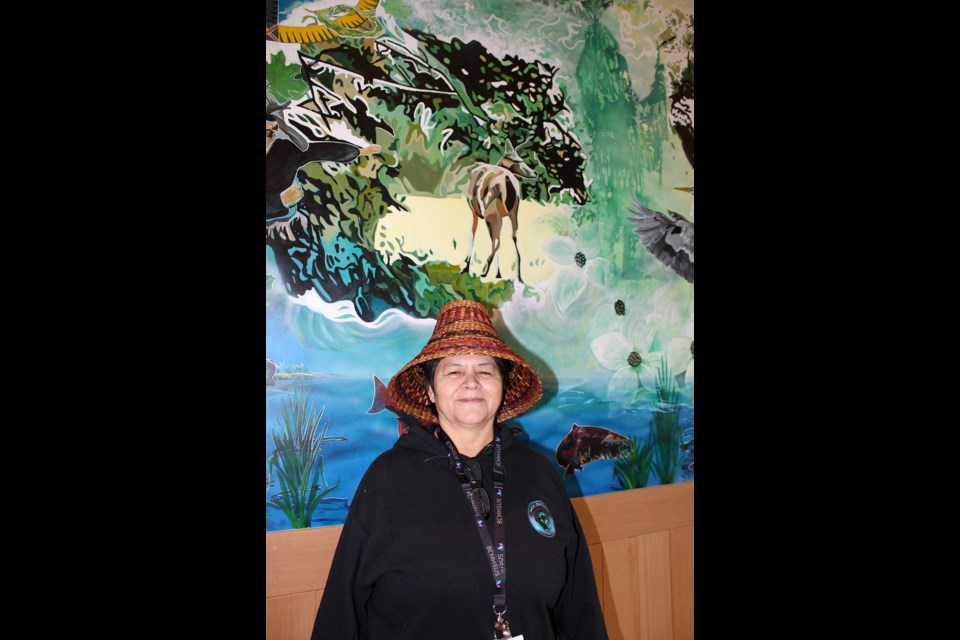To hear Rosalie Dipcsu talk about her work is such a treat.
At less than five feet tall, the visionary artist and healer from the Sḵwx̱wú7mesh (Squamish) Nation bursts with pride and becomes quite animated when she describes her pieces that recently went up at the səmiq̓ʷəʔelə/Riverview Lands in Coquitlam.
After all, Dipcsu said, they tell the stories of the kʷikʷəƛ̓əm and represent the First Nation returning home to its traditional territory.
The spritely Elder was tapped to begin beautifying the historical grounds off Lougheed Highway a few years back.
Her first commission involved wrapping two utility boxes with kʷikʷəƛ̓əm symbols and messages.
Then, in the summer of 2019, came two mural projects for the Red Fish Healing Centre for Mental Health and Addiction, which was officially opened last month by the provincial government, as well as kʷikʷəƛ̓əm First Nation (KFN).
Her first mural, installed at the front of the building, is a graphic work placed on a quarter-inch aluminum panel by EEC Industries of North Vancouver, where Dipcsu lives.
And, like all of her Red Fish art pieces, it has a theme of movement — not only to mirror the migration of the red fish up the Coquitlam River after 100 years, but also to match the vision of the current First Nation as it seeks to take back its land.
Adorned with blue patterns and the KFN logo, the outside mural shows a human face overlooking the flow of the red fish — each of which has internal kʷikʷəƛ̓əm elements — with kʷikʷəƛ̓əm animals in the sky: the coyote, black bear, eagle and heron (the latter of which səmiq̓ʷəʔelə takes its name).
But inside the building, in the Hummingbird Room where patients gather for group talks, Dipcsu and her husband, John Dennis Williams, have transformed a wall with acrylic paints to illustrate KFN’s territory from east to west.
On the left side, Dipcsu said, she’s set the scene at Buntzen Lake showing old and modern-day canoes with paddlers side by side because, despite its population shrinking from 1,000 members to less than 125 today, the First Nation “never lost sight of who they are…. A lot of their history has been forgotten.”
Two hands weaving a basket, at the top of the image, also indicate understanding, time and patience.
In the centre, though, is the Coquitlam Watershed where kʷikʷəƛ̓əm once had its winter gathering site before the Coquitlam dam was built and stopped the First Nations’ community, as well as the fish. A deer represents innocence, while a dancer is pictured to show a spiritual quest for identity. A wise owl looks from above as a land steward.
On the right side, however, is the abundance around the Fraser River, with images of a cedar plank house, a feather, drum, beaver, sturgeon and coyote — the latter being “a trickster” who also keeps the land safe.
Still, Dipcsu included three elements in the “Essence of Spirit” mural though only two immediately pop out to the viewer.
The first is a medicine wheel (replicated on the floor) that’s festooned with native healing plants — cedar, tobacco, sage and sweet grass — and has the four colours of race. On a wall plaque, it reads that
- red people have the gift of vision
- white people have the gift of knowledge
- yellow people have the gift of wisdom
- black people have the gift of movement
“If we use all our given gifts together, we will foresee unity,” the plaque states.
As well, Dipcsu included a medicine man that was inspired by an image of “Quekwatlen” chief Thomas Williams from an article in The Province newspaper on Jan. 18, 1960, when he took away a curse on the colonials in Coquitlam. The man is standing on a bed of Pacific Dogwoods — the floral emblem of British Columbia — “because he sees into the future,” she said.
But there’s an element that Dipcsu tucked away in her mural, too: the letters L-O-V-E.
“I really wanted this to be a place of love and healing,” she said, while scanning the Hummingbird Room. “I wanted people to melt into these images when then going through a critical time in their lives, and not to be judged.”
Dipcsu said the mural took her and Williams about 180 hours, and they got plenty of positive feedback along the way from construction crews and provincial health staff.
In addition, Dipcsu placed white stencils on 36 windows, over three levels at Red Fish, to illustrate a gathering of people, aquatic animals and canoes with fishers throwing an offering to an eagle to share the wealth.
Dipcsu said she hopes her art brings peace and represents hope for the future.
kʷikʷəƛ̓əm Chief Ed Hall, who has known Dipcsu for more than two decades, told the Tri-City News that his friend “has this profoundness for arts, especially working with oil paints and canvas, also wood carving in very significant-sized pieces including old growth that has been given a second life spiritually, and stories brought out of them.”
“I would have to say the works are nothing short of fantastic!” he added. “Her oil painting work has amazed me so much that I’ve had to begin collecting a few pieces for my own and while they were available, as limited-edition runs are few.”
Dipcsu's aim was to “put the KFN on the map in a big way, but also to leave a legacy. The murals are to stop people in their tracks and, in that pause, to reflect and breathe in the past, present and future.”
Though Dipcsu's art is relatively new for the Tri-Cities, her talent is well-known around B.C. She has a cubic installation at Function Junction in Whistler as part of the 2010 Winter Olympics; as well, she painted a Kermode Spirit Bear, which was bought by a communications giant.
As for her next project, Dipcsu is working with PLEA Community Services for a piece at its new Port Coquitlam site.





